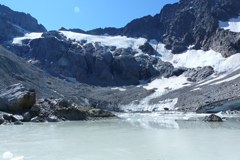News
New hypothesis on deep erosion in high mountain regions
Nov 06, 2008
/
alpMedia
Researchers in the south-east of the Tibetan plateau have found that the moraine dams created during glacier fluctuations have over the millennia helped to slow down the erosion effect of large rivers known as downcutting.
This new hypothesis, which has just been published in the science magazine Nature, is founded on the notion that tectonic lift alone is not solely responsible - as has previously been assumed - for ensuring that the Tibetan plateau has been preserved to this day. Glacier fluctuations also slow down the erosion process. After a glacier has receded, moraines can obstruct the course of rivers. Often a natural dammed lake then forms between the moraine and the glacier, storing up rubble and containing deep erosion. At the same time the lack of rubble discharge in the river courses situated below the plateau means that the downcutting effect is amplified there.
Given this new hypothesis researchers believe that moraine dams will also limit downcutting in the upper courses of mountain streams in the Alps.
Source: www.wsl.ch/news/ (de/fr); Bibliografie: Korup, O., Montgomery, D. R. (2008): Tibetan plateau river incision inhibited by glacial stabilization of the Tsangpo gorge. In: Nature Volume 455 Number 7214. Pages 786-789
Given this new hypothesis researchers believe that moraine dams will also limit downcutting in the upper courses of mountain streams in the Alps.
Source: www.wsl.ch/news/ (de/fr); Bibliografie: Korup, O., Montgomery, D. R. (2008): Tibetan plateau river incision inhibited by glacial stabilization of the Tsangpo gorge. In: Nature Volume 455 Number 7214. Pages 786-789


